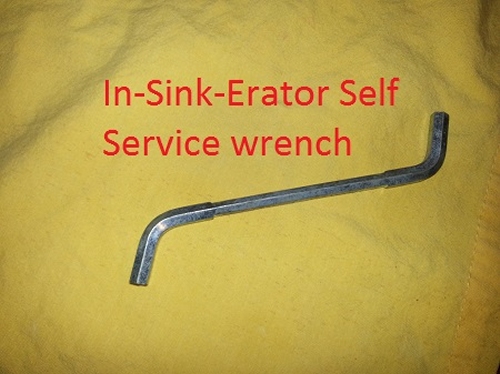
*Garbage Disposal Simple Fixes*
When my wife and I managed apartments, I learned a few simple fixes for garbage disposals. First some safety rules:
A few things you might need when checking your garbage disposal:

If you flip the switch and your garbage disposal won't run, the first thing to check is to make sure it is plugged into the wall socket under the sink. Just follow the cable from the bottom of the unit to the wall socket. I've found more than one where the tenant didn't know why anything would be plugged in under the sink, so they unplugged the garbage disposal and the dishwasher. Then they called for a repair when one or the other didn't work. If direct wired, check the circuit breaker.
If the unit is plugged in or the circuit breaker was in the on position, the next step is to check the built in circuit breaker on the bottom of the garbage disposal unit. Is it popped out? If it is, simply push it in and try the wall switch again. I will push the circuit breaker switch up even if it doesn't appear to have tripped. Flip the switch again. Does the unit spin free or is there an electric hum from a stuck motor. If it spins free, great. If it just hums or trips the breaker (internal or house breaker), you need to find out why it is stuck.
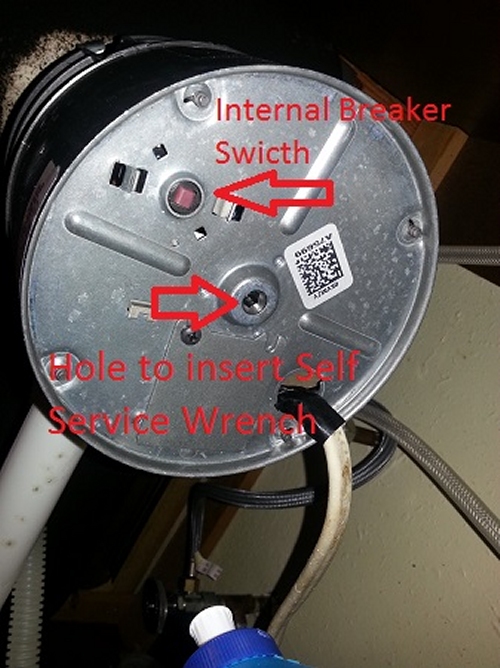
If the unit plugs into a wall outlet, and it WAS plugged in, take a minute to plug your outlet tester into the wall outlet and flip the switch and make sure your wall outlet has power and is wired correctly. If your unit is directly wired into the circuit, then use the non contact voltage tester to see of the wire is live at the unit when the switch is on. If you don't have power then, your problem is beyond the scope of this article. Could be the wall switch, or the wall outlet, or another problem with the circuit and those are a different problem than the ones we are dealing with in this article. Just be sure you checked the wall switch in the up and down position some people like the garbage disposal switch upside down and make sure you're flipping the correct switch and not a light switch for a light above the sink (if there are two switches, try them both even if the light above the sink doesn't light up. The bulb might be burned out and you could end up thinking there was no juice to the circuit by flipping the wrong switch).
If the internal breaker was tripped and the motor only hums, stuck in place, you need to determine why. Now it is time to unplug or turn off the circuit breaker, if it is directly wired into the circuit for the garbage disposal (use the non contact voltage tester to make sure there is no power going to the unit), you don't want the disposal leaping to life while you have tools in the unit. A spinning tool in the unit can seriously injure you, not to mention the damage that could happen to the garbage disposal unit. Garbage disposals aren't cheap (neither are trips to the ER or Urgent Care doctor).
After unplugging the garbage disposal, look down into the disposal from the top with a flashlight. Can you see anything stuck in there? Things I've pulled out of the top of the disposal unit:
If you see something down there, take the tongs and pull it out. SEE SAFETY RULE #1 & #3
Whether you see anything or not in the top, you need to use the self service wrench or an allen wrench on the bottom of the unit. The self service wrench comes with a garbage disposal unit - "food waste disposer self service wrenchette", as it is stamped on the side of the wrench. If you don't have one, you can buy one at the hardware store or just use an allen wrench of the correct size. The self service wrench is just an allen wrench with two heads verses the usual one head and an angled handle. The design gives you clearance and makes it easy to use under the disposal. Insert one of the heads into the hole in the center of the bottom of the unit. Make sure it is seated correctly then turn the wrench back and forth until you can turn the unit freely in both directions one full turn or more. This is usually enough to free up the unit after you pulled anything visible out of the unit's top.
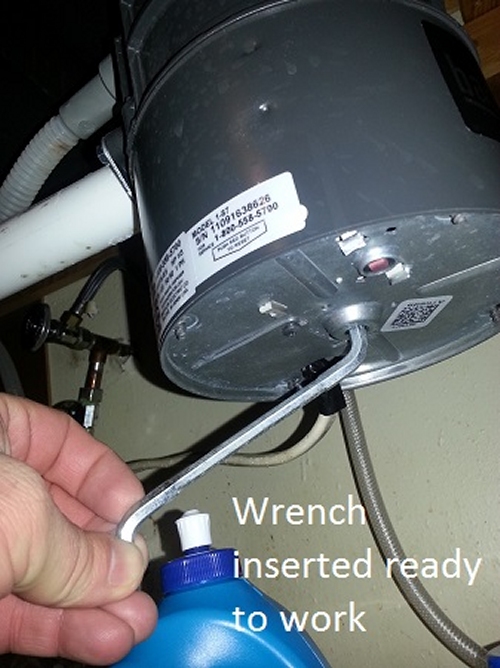
I've read that only InSinkErator garbage disposals have the hex key hole in the bottom of the unit. If your garbage disposal doesn't have a hex key hole in the bottom, you'll need to use a garbage disposal wrench. This T handle wrench has a pivoting head so you can place the wrench in the garbage disposal thru the sink drain. Place the wrench in the business end of the garbage disposal and seat it, then use it to free the cutter blades. I own one of these T handle garbage disposal wrenches but have never had to use it since all the garbage disposals I've worked on were InSinkErator models. One time I did place the wrench inside a garbage disposal and seat it to see how the wrench worked. So I don't have any real experience with how well they do the job from the top.
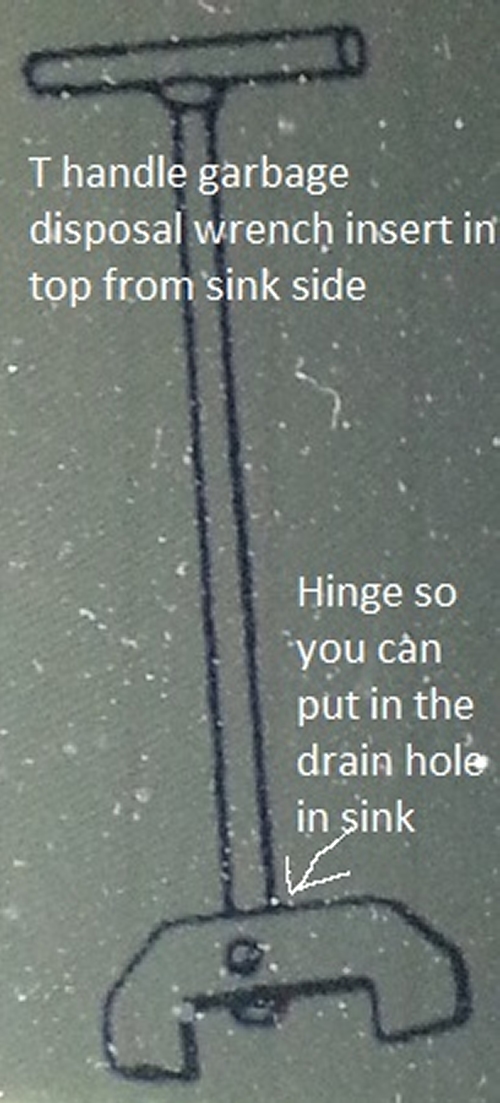
If you find that the unit is hard to turn, or won't turn a full turn in both directions, you need to take a flash light and look in the top from the sink side again. If you see something in there pull it out with the tongs. If you do this a few times and don't see anything in the disposal from the top and still can't get a full turn both directions, but you do have play in both directions, you can try to start the unit. Take all your tools out of the garbage disposal, top and bottom, plug it back in and flip the switch and see if the unit can break loose whatever is stuck inside. I did this once and when the unit started spinning I heard something metallic bouncing around inside. After unplugging the unit what I eventually fished out of the business end of the garbage disposal was a beat up dime. After 15 minutes (the most time I ever spent freeing the cutter blades), I was almost ready to replace that garbage disposal when it freed itself, 10cents almost cost the landlord over $100 for a new garbage disposal, plus I would have charged the landlord an hourly rate for labor on top of that. My wife and I felt sorry for the struggling single mother with a deadbeat boyfriend, so we didn't bill the landlord for my time (partial hours billed as whole hours) because the landlord would have billed the tenant, who couldn't afford it, so it went in the charity work column.
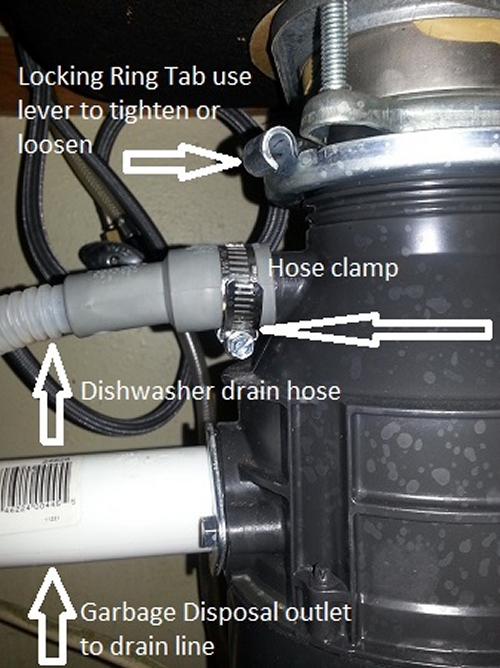
Another problem you might encounter is drips or leaks. Most drips or leaks can be traced to the inlets or the outlet of the garbage disposer. If you have a dishwasher, the inlet for the dishwasher to the garbage disposal is usually above the outlet and generally has a hose clamp holding the hose to the inlet. If you see evidence (wetness or water stains) leading to this area of a leak here, tightening (if a screw type hose clamp) or replacing (if a spring type hose clamp) the hose clamp will usually stop the leak unless the plastic is cracked. Your dishwasher drain line should run up to a vent (air gap) on the top side of the sink then down to the garbage disposal inlet. Check the vent and the lines from the vent for evidence of a leak; water has a tendency to travel away from the actual leak. Check the outlet and drain line for evidence of a leak, you might have to tighten a slip nut or replace a washer to stop a leak here. Another place I've seen a leak is at the top ring where the garbage disposal attaches to the sink. There is a ring on the top of the garbage disposal unit that mates to the bottom of the sink outlet. You can use an allen wrench or the self service wrench to tighten this ring. There are three round holes on the ring. Place a lever in one of the holes and turn to tighten but don't over tighten the ring. The tabs that lock the ring to the sink section aren't very big, and if you over tighten the ring the tabs will slide over the top of the angled tabs on the sink side and the disposal can fall down. That's bad for the pipes, the cabinet, and the disposal unit. They weigh ten or more pounds and you don't want the thing snapping your pipes. That's just more work. You should be able to feel the tabs lock together. The one I had to tighten hadn't been tightened far enough and that was why it leaked. I over tightened it, thinking there was a stop block at the top of the angled tabs on the sink side, and slipped the ring right over the top of the angled tabs and almost dropped the garbage disposer when all the weight was suddenly in my other hand. I was using that hand to push up on the bottom of the garbage disposer. Fortunately, I didn't hurt myself or break anything.
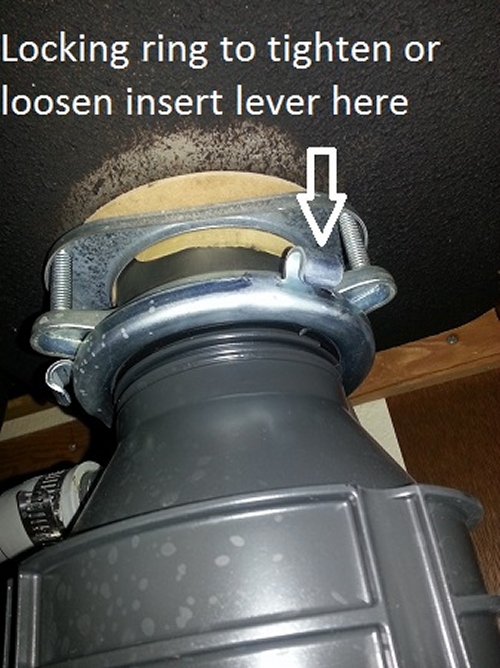
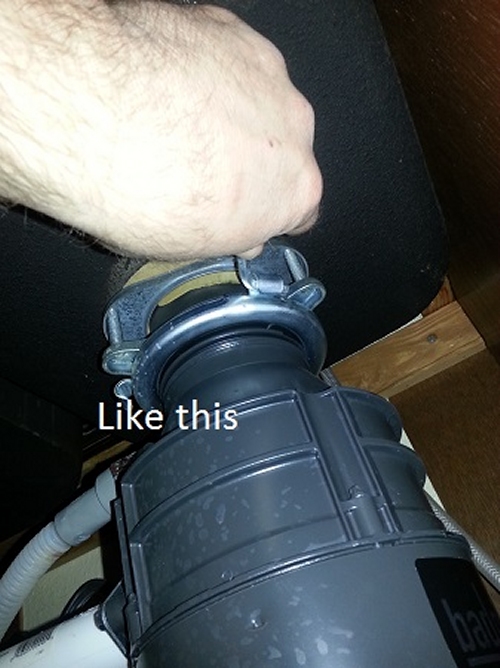
You can prevent some problems by not putting certain items into the garbage disposal things like:
The two items that won't necessarily jam the garbage disposal but WILL plug the drains are grease and rice.
Rice will go thru the disposal mostly intact. The outlet opening is fairly large. From what I can tell by looking at the units I've worked on the blades fling the garbage out the outlet tube as much as they grind the trash down until it will go out the outlet tube. When we managed apartments we had a family that ate a lot of rice and what wasn't eaten at the meal went in the garbage disposal and down the drain, they told me this while discussing the drain bill. The rice made it into the pipes in the walls and floor where the rice sat soaking up water, swelling and expanding until it plugged the drain completely, I've heard other grains do the same thing. How do I know it was rice? The rooter man, he wasn't a plumber all he did was snake drains, said there was a lot of rice in the sink trap and some in the pipe in the wall for sure. The first time the landlord figured everyone has to learn. The second and third time the tenant was sent a bill from the landlord after she paid the rooter man. After that they either learned or they were calling the rooter man themselves since they were going to have to pay the bill anyway. We didn't charge anything over what the rooter man charged so they weren't saving any money if that was what they did.
Grease and cooking oils are similar to rice in that it will generally pass thru the garbage disposer and into the drain lines in the walls and under the floors where it will cool and solidify restricting the drain until it finally plugs. My first experience with grease in the drains was as a teenager visiting my step mother's apartment. She said the managers had talked to all the tenants because they had to call a plumber out to unplug one of the drain lines that was backing up. The plumber told the managers there was grease in the drain lines. The managers told my step mother that they couldn't charge her or any of the other tenants, since they couldn't prove who was putting grease down the drain but did threaten to divide future bills up between all the tenants on that drain line. This is not legal in California and my dad knew it. I admitted to my step mother that I had put grease down the drain and she said she was wondering what I did with all the grease from the pork sausage I was always cooking and not to put the grease down the drain any more to put it in an empty can and take it to the dumpster right away. She said she was sure I wasn't the only one who had put grease in the drains of that building.
My second experience with grease in the drains was as an apartment manager/maintenance man. We had to call the rooter man out 3 times in as many weeks to clear a drain that kept backing up in the same apartment. The rooter man said it was grease in the drain lines. The tenant swore up and down she didn't put grease in the drain and that she didn't eat greasy foods. Being an apartment building we couldn't say for certain it was her so the landlord had to eat the bills. A few weeks later I was fixing a cabinet door in the kitchen of the apartment directly above the unit that had had the drain issue. While fixing the cabinet door the tenant started pouring grease from his cooking into the sink. I told him not to do that or I would send him the bill the next time the drain had to be cleared in the apartment below. He looked dumb founded and said "we do it at my moms house all the time without any problems and I've never had a plugged drain here." Then I explained that the grease was dropping down the pipe in the wall and straight into the pipe in floor of the apartment below where it cooled and solidified clogging her kitchen drain. So while it didn't effect his apartment he was making a problem for the tenant downstairs. Never had a problem with grease in the drain of the unit below after that little conversation. He knew from other tenants if it wasn't normal wear and tear and it was obvious something the tenant did caused a repair to be needed the tenant received a bill for the repair work from the landlord.
If none of these fix your issue with a garbage disposer you might need to install a new one but that is an article for another time. InSinkErator has instructions for this on their website.
In summary if the garbage disposer wont run check to be sure it is plugged into a working outlet/circuit and the internal breaker isn't tripped. Take wash clothes and sponges out of the sink before you drain the wash water. Keep loose change, rice/grains, grease and cooking oil out of the garbage disposer and drain lines. Put food in the compost pile and the other stuff in the trash. If your garbage disposal unit jams unplug the power cord, clear anything out of the top of the unit and a few twist of a self service wrench or garbage disposal wrench might quickly have it working again.
john1lt
www.alpharubicon.com
All materials at this site not otherwise credited are Copyright © 1996 - 2013 Trip Williams. All rights reserved. May be reproduced for personal use only. Use of any material contained herein is subject to stated terms or written permission.